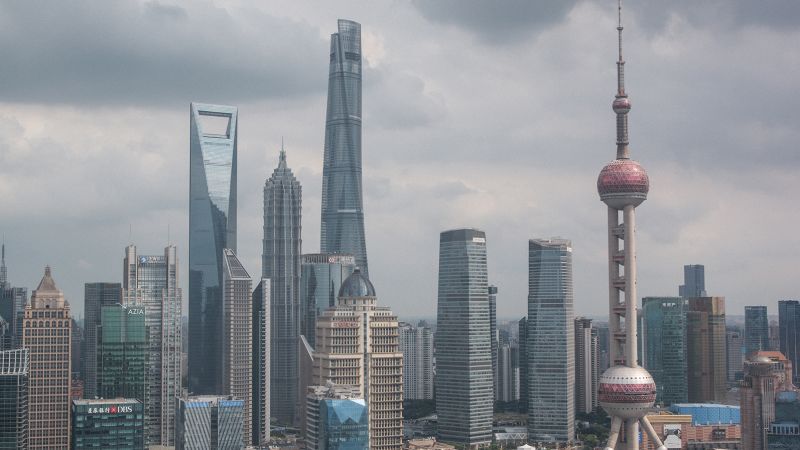China’s Economic Slowdown: A Cause for Concern
China has long been a driving force behind global growth. However, recent weeks have seen its economic slowdown raise alarm bells among international leaders and investors. For the first time in decades, the world’s second-largest economy is itself the problem.
Hong Kong’s Hang Seng Index has fallen more than 20% from its peak in January, officially entering a bear market. Additionally, the Chinese yuan has reached its lowest level in 16 years, prompting the central bank to take unprecedented measures to defend its currency.
The root of the issue lies in the stalling growth after a brief surge earlier this year following the lifting of Covid lockdowns. Consumer prices are falling, the real estate crisis is deepening, and exports are in a slump. The government has even stopped publishing data on youth unemployment due to its severity.
To compound matters, a major homebuilder and a prominent investment company have recently missed payments to their investors. This has reignited fears of a worsening housing market and the potential risks it poses to financial stability.
The lack of decisive measures to stimulate domestic demand and concerns of contagion have led to a new round of growth downgrades. Several major investment banks have lowered their forecasts of China’s economic growth to below 5%.
“We downgrade China’s real GDP growth forecast… as the property downturn has deepened, external demand has weakened further, and policy support has been less than expected,” UBS analysts wrote in a research note.
Nomura, Morgan Stanley, and Barclays had already trimmed their forecasts prior to this.
This means that China may significantly miss its official growth target of “around 5.5%,” which would be a major embarrassment for President Xi Jinping and the Chinese leadership.
This situation is a far cry from the global financial meltdown of 2008, when China led the world with the largest stimulus package and emerged as the first major economy to recover. It is also a reversal from the early days of the pandemic, when China managed to avoid a recession while other major developed economies suffered.
So, what went wrong? Discover the factors behind China’s economic slowdown and the potential implications it holds for the global economy.China’s Economy Faces Growing Concerns as Defaults and Debt Troubles Mount
China’s economy has been facing challenges since April, and concerns have intensified this month following defaults by major companies. Reports of missing interest payments by Country Garden, once the country’s largest developer, have spooked investors and raised fresh concerns about the Chinese economy. Even stronger players in the real estate market are now teetering on the brink of default, highlighting the challenges Beijing faces in containing the crisis.
Debt defaults in the property sector have also spread to the country’s investment trust industry. Zhongrong Trust, which managed billions of dollars worth of funds, has failed to repay investment products to several companies. Angry demonstrators have even protested outside the trust company’s office, demanding payouts on high-yield products.
The property sector’s troubles risk spilling over into wider financial instability, according to experts. With domestic funds seeking safety in government bonds and bank deposits, more non-bank financial institutions could face liquidity problems.
Another major concern is the soaring local government debt, which has been exacerbated by the property slump and the impact of pandemic lockdowns. This fiscal stress not only poses risks to Chinese banks but also limits the government’s ability to stimulate growth and expand public services.
Beijing has implemented incremental measures to boost the economy, but major moves have been avoided due to China’s high debt levels. During the global financial crisis 15 years ago, China rolled out a massive fiscal package that led to an unprecedented credit expansion and increased local government debt. Policymakers are now concerned about further rising debt levels and the long-term consequences.
On Sunday, Beijing policymakers reiterated their commitment to containing systemic debt risks at local governments.
The challenges facing China’s economy are significant, and the actions taken by Beijing will be crucial in determining its future stability and growth.China’s Population Crisis and its Impact on Economic Growth
The People’s Bank of China and the securities regulator are joining forces to tackle a major challenge facing the country. But that’s not the only issue China is facing. It also has a population crisis and strained relations with key trading partners like the United States and Europe.
A Record Low Fertility Rate
China’s total fertility rate, which measures the average number of babies a woman will have over her lifetime, dropped to a record low of 1.09 last year. This is even lower than Japan’s fertility rate, a country known for its aging society. Earlier this year, China released data showing that its population started shrinking for the first time in six decades.
The Economic Impact
Analysts from Moody’s Investors Service warn that China’s aging demographics pose significant challenges to its economic growth potential. The decline in labor supply, along with increased healthcare and social spending, could lead to a wider fiscal deficit and higher debt burden. A smaller workforce could also result in higher interest rates and declining investment. Additionally, housing demand is expected to fall in the long term.
Structural Challenges
Demographics, along with slowing migration from rural to urban areas and geopolitical fracturing, are “structural in nature” and largely outside of policymakers’ control. These challenges are expected to have a long-lasting impact on China’s economy.
The Future Outlook
According to experts, trend growth in China has fallen substantially since the start of the pandemic and is expected to decline further over the medium-term. This paints a concerning picture for the country’s economic future.
Conclusion
China’s population crisis, along with strained relations with trading partners and other structural challenges, is putting a strain on its economic growth potential. The decline in labor supply, increased healthcare and social spending, and falling housing demand are just some of the consequences. As China grapples with these issues, it remains to be seen how the country will navigate its way forward.
Unveiling the Unforeseen Challenges in China’s Economy
China, the world’s second-largest economy, has experienced remarkable growth over the past few decades. Its rapid development has been a subject of admiration and envy for many nations. However, beneath the surface of this economic success story lie unforeseen challenges that threaten to disrupt China’s growth trajectory. In this article, we will delve into some of these challenges and explore their potential impact on China’s economy.
One of the most pressing challenges facing China’s economy is its mounting debt burden. Over the years, China has relied heavily on debt to fuel its economic expansion. This has led to a significant increase in corporate and government debt, which now stands at alarming levels. The International Monetary Fund (IMF) has warned that China’s debt-to-GDP ratio is approaching dangerous levels, posing a systemic risk to the economy. If not addressed promptly, this debt burden could trigger a financial crisis, hampering China’s growth prospects.
Another challenge that China faces is the ongoing trade war with the United States. The trade tensions between the two economic giants have escalated in recent years, resulting in the imposition of tariffs on billions of dollars’ worth of goods. This has had a detrimental impact on China’s export-oriented economy, as it heavily relies on international trade for growth. The trade war has disrupted global supply chains, dampened investor confidence, and slowed down China’s manufacturing sector. As the conflict persists, China must find ways to mitigate the adverse effects and explore new avenues for economic growth.
Furthermore, China’s aging population poses a significant challenge to its economy. The country’s one-child policy, implemented in the late 1970s, has resulted in a rapidly aging population and a shrinking workforce. This demographic shift puts immense pressure on China’s social security system and healthcare infrastructure. Additionally, it hampers productivity and innovation, as a smaller workforce means fewer individuals contributing to economic growth. China must implement effective policies to address this demographic challenge, such as encouraging childbirth and attracting skilled foreign workers.
Environmental degradation is yet another challenge that China must confront. The country’s rapid industrialization and urbanization have come at a great cost to the environment. Air pollution, water scarcity, and soil contamination have reached alarming levels, posing serious health risks and hindering sustainable development. China has made efforts to tackle these issues, such as implementing stricter environmental regulations and investing in renewable energy. However, more needs to be done to ensure a cleaner and greener future for China’s economy.
Lastly, China’s transition from an investment-driven to a consumption-driven economy presents its own set of challenges. Historically, China’s growth has been fueled by investment in infrastructure and manufacturing. However, as the country seeks to rebalance its economy, it must encourage domestic consumption to sustain long-term growth. This transition requires significant structural reforms, such as improving income distribution, enhancing social safety nets, and fostering a culture of consumerism. Successfully navigating this transition is crucial for China’s economic stability and sustainability.
In conclusion, China’s economy, despite its remarkable growth, faces a multitude of challenges that demand immediate attention. From mounting debt and trade tensions to an aging population and environmental degradation, these challenges pose significant risks to China’s economic stability and long-term growth prospects. It is imperative for China’s policymakers to address these challenges effectively through comprehensive reforms and strategic planning. By doing so, China can overcome these obstacles and continue on its path towards becoming a truly resilient and sustainable economic powerhouse.








